Moog Music recently introduced the Minitaur Revolution 2 – an updated version of their analog bass synthesizer module, with new firmware that introduces some significant new features.
The Minitaur Revolution 2 is a deep synth out of the box – delivering classic Taurus-style sounds. And it just gets deeper as you dig into it, offering interesting control voltage modulation options, extensive MIDI options and more.
What is the Moog Minitaur?
Here’s how Moog describes the Minitaur:
Minitaur is a powerful, compact Analog Bass Synthesizer that features a classic one knob per function design. It is the first instrument in the Taurus family that does not have foot pedals. At only 8.5″ x 5.25″ and less than 3lbs, the Minitaur puts legendary analog Moog bass into a package designed to fit seamlessly into today’s performance and production environments.
Two key things to note:
- It’s a bass synth in the Taurus family. Expect it to deliver the bass, not the soprano (It plays notes C5 and lower). And expect it to deliver the classic Moog bass synth sounds heard on so many recordings of the 70’s – not 80’s FM sounds or digital bass sounds.
- It’s designed for modern production and performance environments. So it dispenses with pedals, which few keyboardists are used to playing, and assumes that you will control it via MIDI, computer or control voltages.
The Moog Minitaur retails for about $600. Does it deliver $600 of synth action? Let’s check it out……
The Moog Minitaur Is A Deep Synth, And It Just Gets Deeper
We called the Minitaur a deep synth – and it is.
As soon as you plug in a keyboard and start playing the Minitaur, it unleashes a firehose of classic bass sounds. It’s deep sonically – but also deep in the sense that it taps into close to 50 years of electronic music history.
Elements of the Minitaur’s design can be traced all the way back to Moog’s original 60’s modulars. So, as you tweak the knobs on the Minitaur, you may hear echoes of the sounds of Wendy Carlos, Tangerine Dream, Stevie Wonder, ELP, Giorgio Moroder, Genesis, P-Funk and others.
Key Features Of The Minitaur:
- One knob per function interface
- Two oscillators with Sawtooth (Original Taurus) and Square wave-shapes for each VCO.
- 2 Mixer VCAs for VCO levels control of Oscillators 1 and 2.
- Moog Ladder Filter with adjustable resonance, in the style of the Taurus 1 and 3.
- Two Minimoog style ADSR Envelope Generators for modulating VCF and VCA. The Decay and Release segments are controlled by the Decay knob, while the Release segment is enabled or disabled via Release On/Off switch.
- Midi-syncable LFO with Controls for Rate, VCO LFO Amount, and VCF LFO Amount
- DIN MIDI and MIDI over USB offer complete control of the Minitaur’s sound engine.
- Analog Control inputs for Pitch, Filter, Volume and Gate.
- External audio input for processing external audio through the Mixer and Filter section of Minitaur.
- Headphone output with 1/8″ connection.
- Steel chassis
The Moog Minitaur Hardware
It’s clear that a lot of thought went into creating the Minitaur. The Minitaur has a concise design, focused on the elements used for analog bass sounds. It’s compact, but also feels extremely solid, with a steel case and rugged knobs and switches.
The front is laid out clearly, with a knob for all the main features, so the Minitaur is immediately tweakable. Here’s a summary of the front panel controls:
- VCO2 Frequency
- Oscillator 1 & 2 Saw/Square Waveform Selector – Selects a Sawtooth wave (LED OFF) or Square wave (LED ON) Signal for VCO1 and 2.
- VCO1 Level
- VCO2 Level
- VCF Cutoff
- VCF Resonance
- VCF EG Amount – Bi-polar control sets the (+) or (-) amount of Envelope Generator modulation of the VCF.
- LFO Rate – Range is from 0.01Hz to 100Hz
- LFO VCO Amount
- LFO VCF Amount
- VCA EG Attack – Sets the attack Time of a Minimoog-Style ADSR Envelope Generator used to modulate the VCA. Time ranges from 1 msec to 30 seconds.
- VCA EG Decay/Release – The Release segment of the EG is enabled by the Release On/Off switch.
- VCA EG Sustain
- VCF EG Attack -Sets the attack Time of a Minimoog-Style ADSR Envelope Generator used to modulate the VCF. Time ranges from 1 msec to 30 seconds.
- VCF EG Decay/Release -The Release segment of the EG is enabled by the Release On/Off switch.
- VCF EG Sustain
- Release On/Off Switch – Enables (LED On or Disables (LED Off) the Release segments of both Envelope Generators.
- Glide On/Off Switch
- Glide – Sets the rate of Glide
- Volume
- Fine Tune
- MIDI Indicator LED – Indicates incoming MIDI activity
- LFO Rate Indicator LED
When you look at the list of functions that are packed into the front panel, it’s impressive that Moog was able to do this while also maintaining a very clear layout and large, old-school knobs.
Around the back, the Minitaur is equally clearly laid out:
Back Panel Connections:
- Audio
- Headphones – Jack for stereo headphone output.
- Audio Out – 1/4″ Unbalanced jack.
- Audio In – 1/4″ Unbalanced jack accepts line-level input.
- Analog CV Inputs:
- Pitch CV – 1/4″ TRS Jack accepts 0 to +5V signal (internally processed for 1 V/Octave) via passive Expression Pedals or CVs.
- Filter CV – 1/4″ TRS Jack accepts 0 to +5Vsignal via passive Expression Pedals or CVs.
- Volume CV – 1/4″ TRS Jack accepts 0 to +5Vsignal via passive Expression Pedals or CVs.
- Gate – 1/4″ Jack accepts a 0 (Off)/ +5V(On) Gate signal to trigger the unit’s EGs.
- MIDI:
- MIDI (DIN) – Standard DIN MIDI input for MIDI Control of the MINITAUR
- MIDI (USB) – Type B USB connector for connecting MINITAUR to host for USB MIDI.
- Power
Again, it’s a very concise and compact design that still packs in connectivity for audio in, traditional MIDI, USB MIDI and control voltage connectivity.
The Moog Minitaur As A MIDI Synth
Most users will start off by plugging a keyboard into the Minitaur and using it as a synth module.
We did just that – testing it out by sequencing it and playing it via hardware MIDI:
All sounds, except for the percussion, come from several passes with the Minitaur, including the three basslines, the mid-range synth parts and the high-pitched ‘burbles’.
We expected the Minitaur to work well as a MIDI synth, but were equally impressed by how well it fits into a control voltage studio.
The Moog Minitaur As A Control Voltage Synth
Next up, we tested the Minitaur in a control voltage setup – sequencing it using a traditional Moog style step sequencer (a Synthesizers.com Q960).
Here’s an example, with a single pass of live tweaking in a Berlin-school style context. In this video, the Electribe is only being used to create triggers, via a MIDI-CV convertor, to step the sequencer:
The Minitaur fits into the CV world beautifully, becoming a very cost-effective element in a modular synth. The key functions of the Minitaur – a slew generator, 2 oscillators, a mixer, a VCF & 2 envelopes – would cost twice as much if purchased as individual modules.
If Moog would put the Minitaur behind 5U and Euro panels, it would make a great starter module. While you’re limited to the four control inputs available on the back panel, the Minitaur’s firmware lets you re-map the inputs, so you can use them to control just about anything. More on this below.
It Gets Deeper
We’ve looked at the Minitaur as a synth module and as a part of a control voltage setup. Either way you connect to it, it’s a deep little synth.
It gets deeper, though. The ‘Revolution 2’ firmware update adds a bunch of new features, many of which let the Minitaur be used in a more modular or experimental way.
Here’s what’s added with Rev 2:
- Store up to 100 presets
- A new Decay/Release mode allows for independent control of Decay and Release times from Minitaur’s front panel.
- The Pitch, Volume and Gate Controller inputs can be re-mapped to other control parameters.
- The Minitaur can now act as a CV to MIDI converter – so you can do things like have a modular synth control software running on your computer.
Here’s Moog’s overview of the Rev 2 firmware features:
To take advantage of many of these options, you need to use the Minitaur REV 2 Editor/Librarian. Getting started with the editor is easy, because the UI mirrors the hardware exactly:
Moog’s also made it easy to take advantage of deeper features in the firmware, like mapping the hardware control voltage inputs to various destinations:
It’s great that Moog was able to add this much capability to existing hardware. Some of these new capabilities, like control voltage mapping and CV-to-MIDI conversion, aren’t going to get every day use by most owners. But it’s great that the Rev 2 Minitaur offers that depth, for users to grow into or for users that have more esoteric requirements to begin with.
The one downside to the Rev 2 capabilities is that they venture beyond the one-knob-per-feature hardware interface of the Minitaur. For example, you can save up to 100 presets via the software, but there’s no LED or display on the Minitaur to let you know which patch you have selected.
Minitaur Audio Demos
Here are some audio demos for the Moog Minitaur:
Summary
The Minitaur is Moog’s most affordable hardware synth, yet it’s thoughtfully designed, solidly constructed and surprisingly deep. Whether you want to use it with MIDI hardware, as part of a modular setup or with music software, the Minitaur is a capable and great sounding synthesizer.
Pros:
- The Moog Minitaur is a firehose of analog bass synth sounds that taps into nearly 50 years of synth history
- It’s not just deep sonically, but it has a deep set of features that make it an unusually flexible synth
- The hardware is immediate – generally offering one-knob-per-function
- The design intelligently balances capabilities vs costs to deliver a lot of bang for the buck
Cons:
- Some features are only available via the Editor, breaking the one-knob-per-function paradigm
- The Minitaur’s focus is classic analog bass sounds, so it’s not the best choice if you need a general ‘all-in-one’ synth module.
See the Moog Music site for full details.
If you’ve used the Moog Minitaur Rev 2, let us know what you think of it!
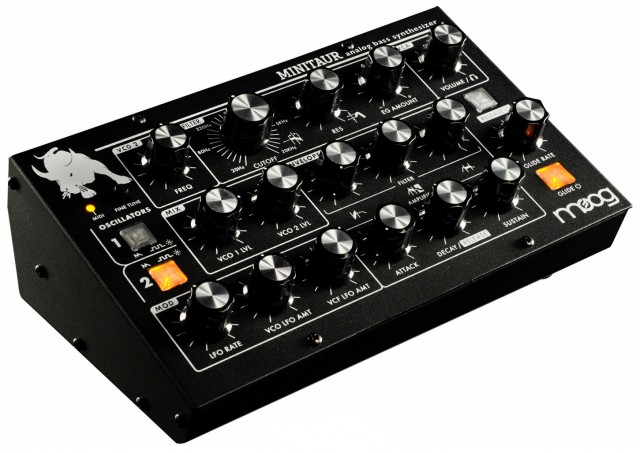
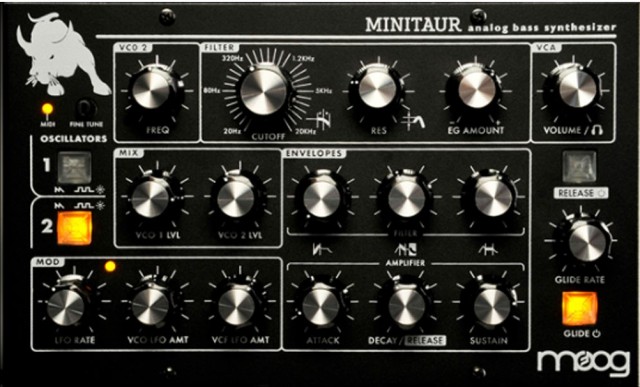
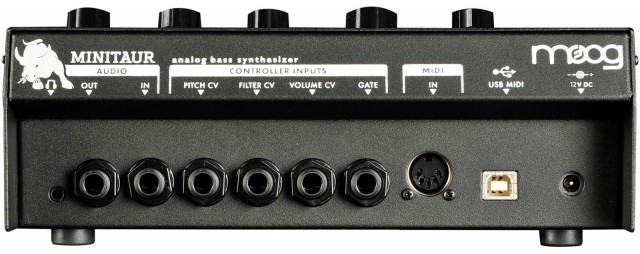
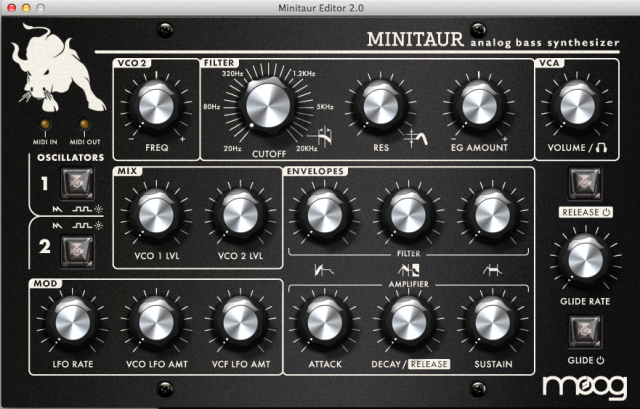
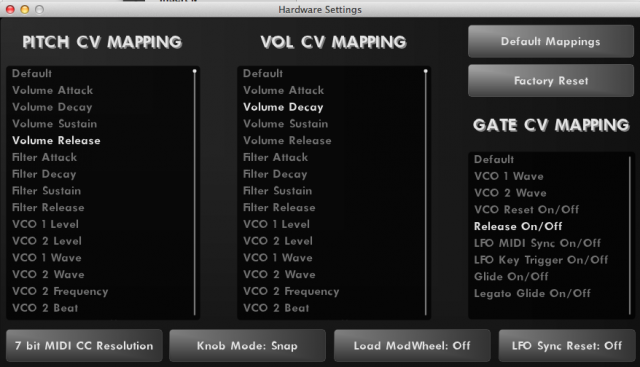

I had freezes at times do to midi in problems with Rev 2. Also the patch storage was not perfect.
Still a very powerful sound and packs a ton of features into a great package.
The Minitaur sounds completely killer and hooks up to anything.
I’d like to see a $800 keyboard version.
It’s called the Sub-Phatty
Sort of, but not really.
The Sub Phatty is a different design, with a lot more features, and isn’t a Taurus-style synth. For example – it’s got a noise generator, variable wave shapes and a sub-oscillator.
They should be able to do a Taurus keyboard for less – but not sure if people would want that when they could get the Sub Phatty for not much more.
I think it’s way more likely that you’ll see a desktop version of the SubP before you’ll see a KB version of the minitaur.
Are you sure you can’t get Taurus style bass from SubPhatty? I’ve never had a Taurus, but this SubPhatty on my desk is pretty sonicly-diverse.
What sort of things have caused the MIDI problems for you and what sort of problems have you had with patch storage?
I’m looking at the Minitaur very seriously, so any details would be appreciated!
I fine synth for sure, but to call it a “one knob per function synth” is a lie… there are many parameters “under the Hood” of this machine making it even better, but they definitely do NOT have a knob available to them.
It really does work as a one-knob-per-function synth until you dig into the power user stuff unleashed with the firmware update. I’ve had my Minitaur since last summer, prior to the update, and it was basically a nice knobby analog module at that point.
The Rev 2 update was a great surprise and adds tons of power. But it’s still a great sounding knobby synth module.
I’d second the idea of a 5U version of this!
This looks more powerful than I expected. The closest competitor is probably the Dark Star and this seems to have both a better sound and more features under the hood.
i would love a cheaper eurorack version with a expander and patch indicator
If you wan’t vintage sound with classic bass, hands down, this is it. Most modern Moog synths have variable oscillators that morph from waveform to waveform, but it changed the VCO circuit and tweaked the sonic sound of the oscillators. The Minitaur doesn’t do this, it has real static waveforms that preserve that classic high fidelity sound.
I also wanted a filter to integrate into my modular, I was going to get the pedal version, but the Minitaur has voltage control inputs that can be configured to any parameter. The squarewave can’t vary it’s pulse width, so I just input it from the modular.
I love the compactness, but PWM is a main go-to for me, and I miss it on the Minitaur.
check into the minibrute, from Arturia. 100 dollars cheaper than this, with PWM via envelope or LFO. I currently have the minibrute, and am getting ready to purchase the minitaur.. what a hellatious combo that would be!
Sorry for being dumb, but is this a software or hardware revision?
your not been dumb, it is firmware upgrade that is worded to sound like it is a hardware upgrade. although it is an outstanding firmware up grade in comparison to your average up grade and the sound still does exactly what says on the tin…….. BASS!
They upgraded the firmware that controls the Minitaur hardware and also the software editor that you can run on your computer to manage patches and settings. .
All new Minitaurs should have the Rev 2 version firmware. People that have an older Minitaur can download the update from Moog.
It amazed me that they could even add features like this in a firmware upgrade, because they aren’t bug fixes or improvements, but completely new functions. Pretty cool!
The Minitaur looks great but what I really want is the modular!
im actually looking for an analogue synth which uses foot pedals so it’s kind of annoying that it’s such a great price and doesn’t have the pedals as I can only find a $900 midi pedal set from Roland which somewhat ups the total price for me :/
only got so many hands, starting to realise pedals are the next ‘step’ for me! (sorry for that pun)
Check out Keith McMillen Instruments MIDI pedal – you can use it with anything.
More articles like this, please. It was great.
Its not worth comparison. The price allonge its worth to hold the minitaure next to me! The sub is not different to that
Can anyway tell me if the Minitaur can sound like a Taurus 3? or if I like that sound of the Taurus 3 should I forget about the Minitaur? how close can they be?
The point of the Minitaur is to capture the Taurus sound in a (comparably) inexpensive module, and I think most people would say it does a good job of that.
There are some differences between the architecture of the Minitaur vs the Taurus 3, that affect the sounds that you can make. The Minitaur and the Taurus 3 both have more features than the original Taurus – adding things like an LFO. The Taurus 3 has more LFO options, than the Minitaur. And the Minitaur adds square wave switches for the VCOs, while the Taurus 3 only does sawtooth waves.
For the most part, whether the difference in synth options matter to you or not gets into ‘purist’ territory. They both have presets that come very close to matching the three presets of the original Taurus, and they both can do a lot of things that the original Taurus could not do.
A bigger deal for me would be the fact that the Taurus 3 has pedals and features like an arpeggiator. That and the Taurus 3 costs $1400 more.
sorry if that’s a dumb question, but does storing 100 presets on the unit mean you can also recall from the minitaur itself? if so, how is it done without a display? or do you still have to employ a computer for loading a patch?
You use the push-button switches, holding the glide and osc1 to scroll up the preset list and glide/osc2 to scroll down.
Works great, but it would be nice to have a readout that indicated the patch name/number.
Side by side on stage, the Minitaur produces a more substantial bass than the Subphatty. I’m loving the Subphatty as a versatile “jack of all trades” monosynth, but as soon as I want to shake the room I find myself reaching for the Minitaur. I also find I can move seamlessly between a bass guitar and the Minitaur without any loss of the organic quality of the stringed instrument, something that I’ve only been able to do comfortably in the past with the original Novation Bass Station. I do wish I could undo the Rev. 2 upgrade as I find myself too easily relying on the presets instead of dialing in my own sounds. I don’t know how the Minitaur compares to a Taurus, but it’s the best thing that has happened to my bass rig in a long time.
is this different then the update released a few months ago? I haven’t recieved an email from them, and their website doesn’t have anything new on the miniataur….
I love the sound of the Minitaur, much better than the cleaner sound of the Little/Slim Phatty. The oscillators have that bright but still huge sound that a lot of vintage analogs have, and the filter is classic Moog. All the knobs make it easy to use. The main problem for me is the C5 note limit. I play a lot of prog, and it’s impossible to play some higher Keith Emerson style leads on the Mintaur. It would be the perfect mono synth if it didn’t have that limitation.
the c5 limit is not arbitrary, it is because of voltage to note… and power supply limitations.. i am no electrical engineer, so probably am explaining it poorly, but in order to produce the true low tones it does, it was built with that in mind. i think the power supply would have to be twice as big to add another octave… the only thing i wish it had was a noise osc to mix in, ….
too expensive for what it does !!! for that price you have a DSI TETRA polyphonic and more with a whole lot of functions in addition !!! after it sounds good, like almost all moog, moog I like the sound, but I really find their synths too expensive for what they do …
yes probably yes but man … that tetra is a shoe-box with a small screen full of sub.menus. Is fantastic synth of course but most of the synthesis parameters are hidden in a lcd screen and people love the immediacy. Im of the opinion that the good thing about hardware syntesizers is that they must be full of knobs , all parameters controlled with your hands … thats the cool thing , and this minitaur gives you the hands-control over 90% parameters. And … its a moog man … allow me a comparison : a moog is like a “porsche” , prestigious company , probably not so good for some people but moog is a legend brand, a “leading brand in the market” so it could be a reason to increase the price. Not sure , its only an opinion.
Does anybody know how you use minitaur without a pc? If i plug my headphones in minitaur, i hear nothing
Not sure what you’re asking! What’s your PC have to do with it?
Do you have a MIDI keyboard connected to it? You should be able to just plug in a MIDI keyboard and start playing.
Do you know anything about synthesizers/MIDI? Wow. Plug a MIDI keyboard into the Minitaur first.